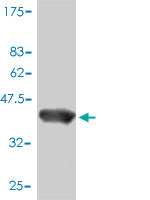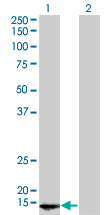POLR2D Antibody (monoclonal) (M01)
Mouse monoclonal antibody raised against a full length recombinant POLR2D.
- SPECIFICATION
- CITATIONS
- PROTOCOLS
- BACKGROUND

Application
| WB |
|---|---|
| Primary Accession | O15514 |
| Other Accession | BC017205 |
| Reactivity | Human |
| Host | mouse |
| Clonality | Monoclonal |
| Isotype | IgG1 kappa |
| Clone Names | 1E4-A5 |
| Calculated MW | 16311 Da |
| Gene ID | 5433 |
|---|---|
| Other Names | DNA-directed RNA polymerase II subunit RPB4, RNA polymerase II subunit B4, DNA-directed RNA polymerase II subunit D, RNA polymerase II 16 kDa subunit, RPB16, POLR2D |
| Target/Specificity | POLR2D (AAH17205, 1 a.a. ~ 142 a.a) full-length recombinant protein with GST tag. MW of the GST tag alone is 26 KDa. |
| Dilution | WB~~1:500~1000 |
| Format | Clear, colorless solution in phosphate buffered saline, pH 7.2 . |
| Storage | Store at -20°C or lower. Aliquot to avoid repeated freezing and thawing. |
| Precautions | POLR2D Antibody (monoclonal) (M01) is for research use only and not for use in diagnostic or therapeutic procedures. |

Thousands of laboratories across the world have published research that depended on the performance of antibodies from Abcepta to advance their research. Check out links to articles that cite our products in major peer-reviewed journals, organized by research category.
info@abcepta.com, and receive a free "I Love Antibodies" mug.
Provided below are standard protocols that you may find useful for product applications.
Background
This gene encodes the fourth largest subunit of RNA polymerase II, the polymerase responsible for synthesizing messenger RNA in eukaryotes. In yeast, this polymerase subunit is associated with the polymerase under suboptimal growth conditions and may have a stress protective role. A sequence for a ribosomal pseudogene is contained within the 3' untranslated region of the transcript from this gene.
References
Genetic polymorphisms in 85 DNA repair genes and bladder cancer risk. Michiels S, et al. Carcinogenesis, 2009 May. PMID 19237606.Systematic analysis of the protein interaction network for the human transcription machinery reveals the identity of the 7SK capping enzyme. Jeronimo C, et al. Mol Cell, 2007 Jul 20. PMID 17643375.Will diverse Tat interactions lead to novel antiretroviral drug targets? Harrich D, et al. Curr Drug Targets, 2006 Dec. PMID 17168834.The regulation of HIV-1 transcription: molecular targets for chemotherapeutic intervention. Stevens M, et al. Med Res Rev, 2006 Sep. PMID 16838299.Inhibition of HIV-1 virus replication using small soluble Tat peptides. Agbottah E, et al. Virology, 2006 Feb 20. PMID 16289656.
If you have used an Abcepta product and would like to share how it has performed, please click on the "Submit Review" button and provide the requested information. Our staff will examine and post your review and contact you if needed.
If you have any additional inquiries please email technical services at tech@abcepta.com.













 Foundational characteristics of cancer include proliferation, angiogenesis, migration, evasion of apoptosis, and cellular immortality. Find key markers for these cellular processes and antibodies to detect them.
Foundational characteristics of cancer include proliferation, angiogenesis, migration, evasion of apoptosis, and cellular immortality. Find key markers for these cellular processes and antibodies to detect them. The SUMOplot™ Analysis Program predicts and scores sumoylation sites in your protein. SUMOylation is a post-translational modification involved in various cellular processes, such as nuclear-cytosolic transport, transcriptional regulation, apoptosis, protein stability, response to stress, and progression through the cell cycle.
The SUMOplot™ Analysis Program predicts and scores sumoylation sites in your protein. SUMOylation is a post-translational modification involved in various cellular processes, such as nuclear-cytosolic transport, transcriptional regulation, apoptosis, protein stability, response to stress, and progression through the cell cycle. The Autophagy Receptor Motif Plotter predicts and scores autophagy receptor binding sites in your protein. Identifying proteins connected to this pathway is critical to understanding the role of autophagy in physiological as well as pathological processes such as development, differentiation, neurodegenerative diseases, stress, infection, and cancer.
The Autophagy Receptor Motif Plotter predicts and scores autophagy receptor binding sites in your protein. Identifying proteins connected to this pathway is critical to understanding the role of autophagy in physiological as well as pathological processes such as development, differentiation, neurodegenerative diseases, stress, infection, and cancer.



